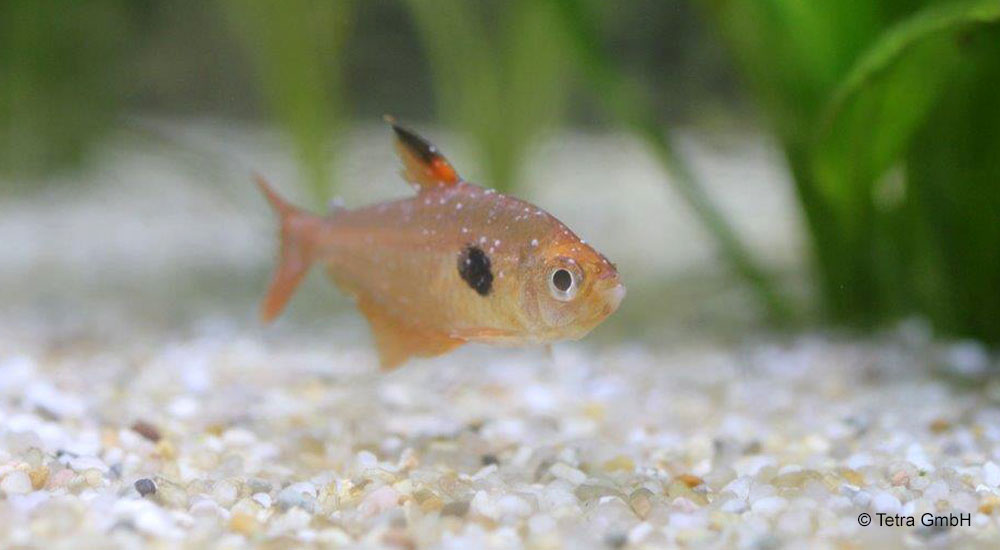Mucous membrane and gill parasites
Symptoms: Sometimes, aquarium fish can be infected with mucous membrane and gill parasites without you noticing anything. This is because minor infections tend to be without symptoms and most of the potential pathogens are microscopic. The symptoms only become apparent in severe cases and None are indicative of a specific parasite. They include a dull mucous membrane, rubbing against objects in the tank and heavy, unnatural breathing.
Cause: The best known of these mucous membrane and gill parasites includeSingle-celled organisms such as Costia, Trichodina, Chilodonella as well as Ichthyophthirius and Oodinium (the latter two are described below). The multi-celled organisms include skin and gill worms of the Gyrodactylus and Dactylogyrus genera.
Remedial action: You can find suitable medication in pet stores. Please remember that well-kept fish have a healthy immune system and can therefore often keep pathogens at bay by themselves.
White spot disease
Symptoms: Your fish have white, pinhead-sized dots on their skin and fins. Their mucous membrane may also be peeling off in places. They are rubbing against objects and breathing heavily. Please note that the white spots only develop in the course of the infection. You should also watch out for ‘Ichthyo’ (white spot) when the initial unspecific symptoms appear and start the treatment as quickly as possible.
Cause: The symptoms are caused by a single-celled skin parasite called Ichthyophthirius, which is generally introduced when adding a new stock of fish. ‘Ichthyo’ infects virtually all freshwater and brackish fish, and can also escalate rapidly.
Remedial action: Carry out a partial water change without delay and buy a suitable medicine from a specialist retailer immediately to treat the infection. Please make sure that you stick to the exact usage and treatment instructions specified on the product. In most cases, several consecutive treatment cycles are required.
Fin rot & mouth decay
Symptoms: The fins of infected fish look frayed and the edges of the fins may appear whitish. Many fish also have open wounds, especially at their fin base. The mucous membrane and eyes may look cloudy. In cases of mouth decay, fish often have a whitish, cotton wool-like covering and tissue damage on their mouth.
Cause: These infections are caused by bacteria. However, they are often signs that something else is amiss because they predominantly target fish that have a weakened immune system, are infested with skin and gill parasites, are kept in poor conditions or are generally stressed.
Remedial action: Apart from using a suitable medicine, it is vital to take measures to improve the environmental conditions, reduce stress and boost your fish’s health. These include carrying out a partial water change, cleaning the substrate, generally improving the water quality, providing a diet that improves the fish’s health and checking the fish stock (avoiding overstocking, taking social compatibility into account). Specialist retailers can provide effective medicines that must be used in line with their instructions. You should never use antibiotics unless prescribed by a vet.
Fungal infections
Symptoms: Cotton wool-like patches appear on the skin and fins. These often subsequently form around the edges of wounds or in inflamed areas.
Cause: Fungal infections are triggered by fungal spores, e.g. of the Saprolegnia genus, which are always present in the water. They mainly affect fish with a weakened immune system or which are injured and have damaged mucous membranes.
Remedial action: Fungal infections can be treated with suitable medicines from specialist retailers. However, you should always remember that these are secondary infections and therefore the main cause needs to be found and treated. This means that you need to improve the living conditions, e.g. the water quality, and that you should bear in mind that your fish may also have a parasitic or bacterial infection.
You should also check your fish stock: check whether your fish get along together well and how they react to measures to boost their fitness (e.g. feeding). At the same time, you need to establish the cause of the problem. Are the water values correct? Is the temperature suitable for the species of fish? Could the fish be wounded?
Fish tuberculosis
Symptoms: The fish have sunken or bloated bellies. They may develop bulging eyes or bellies and parts of their fins may be shortened and frayed. They seem pale or their skin is inflamed. In many cases, their scales stick up or even fall off. The fish appear lethargic and isolate themselves. Take note: in the early stages of the disease, your fish may seem fighting it as the pathogens initially spread in the internal organs.
Cause: Fish tuberculosis is caused by bacteria of the Mycobacterium genus. These bacteria are naturally present in the tank and mainly affect fish with a weakened immune system as well as stressed or old fish. Fish tuberculosis may progress slowly or very quickly or even lie latent, but it is always infectious.
Remedial action: Fish tuberculosis itself cannot be treated with medicine, but you can certainly stop its progress. It is vital to improve the living conditions. Offer your fish the water values they need, carry out regular partial water changes and feed them only top-quality brand foods. Check the stocking density, for example. Please note that in extremely rare cases, mycobacteria may infect open wounds in humans, triggering a harmless, local and treatable skin inflammation and skin hardening. If you have a wound on your hands, you should always wear suitable gloves when putting your hands in the aquarium, for hygiene reasons.
‘Hole in the head disease’
Symptoms: Cavities start to develop, particularly on the head of the fish, small at first then increasingly bigger. In many cases, a whitish, pimple-like coating becomes apparent. Fish look as though the tissue around the head is eroding away.
Cause: The exact cause of ‘hole in the head disease’ is far from clear, but a group of single-celled intestinal parasites, e.g. Hexamita, are thought to be at least partly responsible. Bacteria and potentially a lack of minerals or nutrients could also be the cause of the “hole in the head disease”. Incorrect water values or food also play a key role in the development of the disease.
Remedial action: Affected fish should be fed a diet that is as varied and nutrient-rich as possible (only use top-quality brand foods). Make sure to offer your fish a stress-free environment and ideal water values. For cichlids in particular, social stress due to combining incompatible fish species often causes the disease. The single-celled intestinal parasites can be treated with suitable medicines from pet stores.
Velvet disease
Symptoms: Fish affected by this disease look as though they have been coated in gold dust or icing sugar. The greyish-yellow velvety coating first appears on the fins and gills before spreading over the entire body. The fish secrete increasing amounts of mucous, breathe heavily, rub against objects and contract their fins. They often reject their food.
Cause: This disease is caused by dinoflagellates of the former Oodinium genus (now referred to as Piscinoodinium), which are introduced into the tank by new fish.
Remedial action: Specialist retailers can provide effective medicines that must be used in line with their instructions, especially regarding the treatment duration.
Ammonia or nitrite poisoning
Symptoms: Fish have real difficulty breathing and may gasp for air at the surface. They often seem listless or swim frantically. They are pale and swim erratically.
Cause: Fish complaints are not always caused by pathogens or parasites; sometimes they may be symptomatic of poisoning, either due to excessive amounts of ammonia or nitrite in the water.
Remedial action: As a general rule, you should always scrutinise the living conditions: Is the fish stock too dense? Was the aquarium biologically ‘run in’ properly? Have the fish been overfed? Are there any fish corpses that have not been discovered? Have the fish recently been given medicines that have killed the precious biological filter bacteria.
Check the ammonia and nitrite values in the aquarium. If the values are high, carry out a partial water change immediately. High ammonia or nitrite values are always a sign that the biological filtration is damaged or inadequate. Bear in mind that you need to clean the filter correctly to avoid damaging the essential filter bacterial. Bacteria starters are advisable, both in this case and as part of the ‘run-in’ process of an aquarium.

